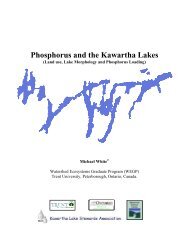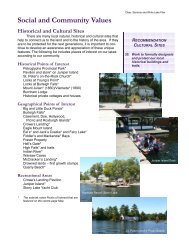Lake Water Quality 2006 Report - Lakefield Herald
Lake Water Quality 2006 Report - Lakefield Herald
Lake Water Quality 2006 Report - Lakefield Herald
Create successful ePaper yourself
Turn your PDF publications into a flip-book with our unique Google optimized e-Paper software.
18Chl a (ug/L)1260Pigeon <strong>Lake</strong> SPigeon <strong>Lake</strong> CPigeon <strong>Lake</strong> NSturgeon <strong>Lake</strong> SSturgeon <strong>Lake</strong> CSturgeon <strong>Lake</strong> NLovesick <strong>Lake</strong> 1Lovesick <strong>Lake</strong> 2Lovesick <strong>Lake</strong> 3Stony <strong>Lake</strong> 1Stony <strong>Lake</strong> 2Stony <strong>Lake</strong> 3Figure 2. Concentration of phytoplankton at sampled sites.We were very surprised to see such low concentrations of attached algae on theplants growing at Snug Harbour in Sturgeon <strong>Lake</strong> (Sturgeon <strong>Lake</strong> S) as this site hashistorically had some of the highest concentrations of total phosphorus throughoutthe Kawarthas. Looking at phytoplankton concentrations (Figure 2) may offer apossible explanation. This same site had the highest concentrations of phytoplanktonby several orders of magnitude. Thus the relatively low amount of epiphytes andmetaphyton associated with the macrophytes at Snug Harbour is likely related to amore turbid water column where light is a limiting factor for successful growth. Toput those numbers in context, chlorophyll a concentrations in the pea-soup days ofthe Great <strong>Lake</strong>s routinely exceeded 100 µg . L -1 . As you can see from Figure 2, thiswas many times higher than today’s levels.50





